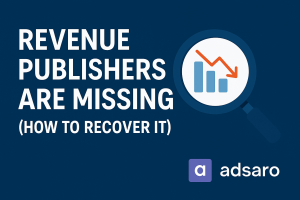In digital publishing, striking the right balance between website performance and ad monetization is key. Lazy loading, a performance optimization technique, delays the loading of off-screen content until users scroll to it. While this improves site speed and user experience, many publishers question the impact of lazy loading on ad revenue. Can it reduce earnings? Or does it lead to higher-quality impressions and increased advertiser interest?
This blog breaks down the connection between lazy loading and ad revenue—highlighting the benefits, drawbacks, and best practices to help you optimize your ad setup without compromising revenue potential.
What Is Lazy Loading in Advertising?
Lazy loading is a web development technique that defers the loading of non-visible elements—like images or ad slots—until they’re about to appear on a user’s screen. In advertising, this means that ad calls are only made when a user scrolls close to an ad placement.
Instead of loading all ads at once (even those at the bottom of a long article), lazy loading helps prioritize only what’s likely to be viewed. This strategy reduces server requests, boosts page load times, and improves user experience—making it an essential tool for publishers and developers alike.
Benefits of Lazy Loading for Ad Revenue
1. Faster Website Speed Leads to Better User Retention and Engagement
Lazy loading reduces the time it takes for the initial page to load by preventing unnecessary asset loading. A fast site keeps users engaged, lowers bounce rates, and increases time spent on site—all of which indirectly improve ad monetization potential.
When users stay longer and interact more, there are more opportunities for ads to load and be viewed. This shows how website speed and ad monetization go hand in hand.
2. Improved Ad Viewability Drives Higher CPMs
Advertisers pay more for inventory that’s seen. Lazy loading only triggers ad requests when an ad is in or near the user’s view, improving ad viewability metrics. Higher viewability leads to better CPM rates, more competitive bids, and stronger relationships with demand partners.
By tying ad viewability and lazy loading together, publishers can offer more premium, measurable inventory—something advertisers prioritize.
3. Prevents Wasted Impressions and Strengthens Inventory Quality
In traditional setups, ads load regardless of whether the user scrolls to them or not. This results in “wasted” impressions that dilute reporting metrics and lower the average value of your ad inventory.
Lazy loading ensures that impressions are counted only when there’s a strong chance they’ll be seen, thereby improving the integrity of your data and making your inventory more attractive to buyers.
Drawbacks of Lazy Loading on Ad Revenue
1. Reduced Ad Impressions Can Lead to Lower Gross Revenue
If users don’t scroll far enough to trigger certain ad placements, those impressions are never served. While they may not have been “viewable” anyway, this still reduces total ad fill and gross revenue—especially if you rely heavily on long-form content with multiple ad slots.
Understanding this trade-off is vital when evaluating the impact of lazy loading on ad revenue.
2. Delayed Auction Requests May Lower Bid Value or Fill Rates
Ad auctions are time-sensitive. If lazy loading triggers an ad request too late (e.g., just as it comes into view), some demand partners may not have time to bid or return high-value offers. This results in missed revenue opportunities or low-paying fallback ads.
To counter this, lazy loading needs to be smartly configured to balance performance and monetization without disrupting auction flow.
3. Compatibility Issues with Certain Ad Tech Providers
Some header bidding wrappers, demand-side platforms (DSPs), or analytics tools may not play well with lazy loading setups. This can lead to missed impressions, faulty tracking, or even underperformance—especially if these systems rely on early ad calls to process bids.
Ensuring your tech stack is fully compatible with lazy loading best practices for publishers is essential before making the switch.
Lazy Loading Best Practices for Publishers
1. Use Pre-Viewport Triggering to Ensure Timely Ad Requests
Instead of loading ads exactly when they enter the viewport, set a buffer (e.g., 300–500 pixels above). This gives the ad time to load and register viewability correctly—avoiding late loads that hurt your metrics.
This small change can have a big impact on lazy loading and ad revenue outcomes.
2. Do Not Lazy Load Above-the-Fold (ATF) Ads
Your top placements are typically the highest earners. They attract premium bids and need to load immediately. Delaying them can drastically reduce revenue and impact your site’s perceived quality.
Avoid lazy loading for above-the-fold units to preserve revenue from your most valuable impressions.
3. Track User Scroll Depth to Optimize Ad Placement
Using scroll tracking tools allows you to understand how far users typically scroll. This helps you identify underperforming placements and fine-tune lazy loading behavior accordingly.
Pairing this data with A/B testing can help refine your ad strategy for optimal performance.
4. Run Controlled A/B Tests to Measure Lazy Loading Impact
Comparing performance with and without lazy loading across different ad placements gives you hard data on its effectiveness. Monitor metrics like viewability, impressions, RPM (revenue per mille), and bounce rate to make informed decisions.
These insights will help you tailor a lazy loading approach that works for your unique audience and layout.
5. Ensure Compatibility with Your Ad Tech Stack
Before implementing lazy loading across your site, test for compatibility with ad servers, SSPs, and header bidding frameworks. Confirm that lazy-loaded ad slots can trigger timely and accurate bid responses, impression tracking, and viewability measurement.
This step is often overlooked but can make or break your lazy loading success.
Conclusion
The impact of lazy loading on ad revenue is multifaceted. When implemented correctly, it enhances website performance, boosts ad viewability, and prevents wasted impressions—leading to better monetization over time. However, if misconfigured or applied across the board without consideration, it can reduce total impressions and disrupt bidding.
For publishers, the key is balance. Use lazy loading to support a faster, cleaner experience for users while preserving and enhancing your most valuable ad placements. By following Google’s Lazy Loading Best Practices, you can ensure that performance optimization goes hand-in-hand with revenue growth.








Leave a Reply